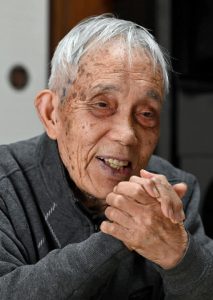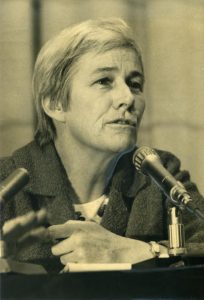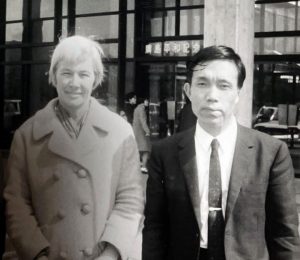My guidepost, Hiroshima pioneers: Hiromu Morishita, 93, A-bomb survivor and teacher, speaks about Barbara Reynolds
Apr. 1, 2024
Took on suffering of A-bomb survivors as if her own
by Hiromi Morita, Staff Writer
Hiromu Morishita has devoted his life to peace education. Mr. Morishita said what paved the way for him was his participation in the 1964 Hiroshima–Nagasaki World Peace Pilgrimage, which traveled to nuclear weapons states and other countries to convey the reality of the atomic bombings. “That was all thanks to Barbara,” he said as he recalled the American peace activist Barbara Reynolds, the proponent of the pilgrimage who died in 1990.
According to Mr. Morishita, “She truly was a person of honorable poverty with an anti-nuclear spirit.” Ms. Reynolds, who later became a Special Honorary Citizen of Hiroshima, first moved to Hiroshima in 1951 when her husband was assigned to work at the Atomic Bomb Casualty Commission (ABCC; present-day Radiation Effects Research Foundation). She was deeply moved after coming into contact with the reality of the devastation caused by the atomic bombing and devoted herself to related activities. She and her family sailed the seas on a boat to protest nuclear testing and, in 1962, toured the United States, the Soviet Union, and other nations with two representative A-bomb survivors, including the late Miyoko Matsubara. Her response to those experiences in the form of a call for larger-scale action culminated in the 1964 pilgrimage.
In a manuscript Mr. Morishita wrote, “I experienced the A-bombing. And I want to do something useful and travel overseas.” With the manuscript in hand, he paid a visit to a selection committee where Ms. Reynolds awaited his arrival.
In the written manuscript, he vividly recounted his experience in the atomic bombing while working as a mobilized third-year student at the first Hiroshima Prefectural Junior High School (present-day Kokutaiji High School) as well as the severe burns to his face and other areas of his body that he had suffered. He also revealed his struggles after becoming a school teacher, to the point where he had considered giving up his work due to the emotional pain he suffered when students caught sight of the keloid scars on his face.
A short time later, he received a telegram indicating his selection as a participant in the peace pilgrimage. He took a sabbatical from the high school where he worked and embarked on the 75-day journey. The first country the pilgrimage visited was the United States, the country that dropped the atomic bombs. There, at schools and gatherings, he spoke about his A-bombing experience while staying in the homes of supporters. “Although some people there justified the atomic bombing, I met many well-meaning citizens who listened intently to my story.” With that experience, he came to realize the significance of direct dialogue.
As part of the pilgrimage, he was also able to meet with former U.S. President Harry Truman. Although the occasion was widely reported in the local media, the meeting lasted all of three minutes. In his notes at the time, Mr. Morishita wrote about how the encounter “ended too soon and felt like a total letdown.” Another of his notes read, “He didn’t even say anything that resembled an apology.”
“It was a really difficult trip, but Barbara had thought about effective activities and made all the necessary arrangements,” said Mr. Morishita. “As I had been doing calligraphy and writing poetry, she introduced me to local cultural figures despite her busy schedule at the time.” He added, “I was pleased by all the attention she paid me.”
However, the costs of the pilgrimage, which had been covered by donations and the like, became problematic midway through the journey. Mr. Morishita described that, “Barbara never gave up, and we continued on using her money.” He drew inspiration from her strong belief in what they had set out to do.
After the pilgrimage, Mr. Morishita returned to Japan and devoted himself to peace education. Realizing there was little mention of the A-bombings in textbooks in Japan, he set about creating teaching materials with other teachers. He said, “It might have been Barbara’s influence that made me do more than simply be satisfied with returning to Japan.”
The year after the pilgrimage, Ms. Reynolds founded the World Friendship Center (WFC) in Hiroshima with Tomin Harada, a physician with whom she had a close friendship and who died in 1999. After returning to the United States in 1969, she continued her efforts to communicate to the public the reality of the atomic bombings, including by opening the Hiroshima and Nagasaki Memorial Collection at Wilmington College in the U.S. state of Ohio, as well as to provide support for refugees.
Seeing Ms. Reynolds at work in that way, Mr. Morishita decided to take over the post of WFC chair from Mr. Harada, the organization’s first chair, with the thought of “giving back.” He served as WFC chair, starting in 1986, for more than 25 years. In particular, he put his energies into constructing a monument, unveiled in 2011, to Ms. Reynolds. The monument is inscribed with the words, “I, too, am a Hibakusha.” The words were chosen to symbolize Ms. Reynolds, who always stood by A-bomb survivors and worked to share their pain.
As time passes, fewer and fewer people are able to speak directly about the scars that the A-bombings caused in human beings. There is an urgent need to pass on that information to future generations but, Mr. Morishita insisted, “Most important is whether other people can accept those stories as their own.” He strongly hopes that young people learn of the path taken by Mr. Reynolds, who went beyond saying how bad the A-bomb survivors had it and was able to say, ‘I, too, am a Hibakusha,’”
Profile
Hiromu Morishita
Born in the present-day town of Osaki-kamijima in Hiroshima Prefecture, Mr. Morishita experienced the atomic bombing at the age of 14. After graduating from Hiroshima University’s School of Letters, he worked at a private high school before becoming an instructor at a prefectural high school. He engaged in the work of peace education by conducting surveys of the consciousness of high school students regarding the atomic bombings and creating teaching materials. He also served as the first president of the Hiroshima prefectural high school A-bomb survivor teachers’ association. A poet and calligrapher, he taught calligraphy at Shimane University and Hiroshima Bunkyo University after retiring from his role as school teacher. Mr. Morishita currently lives in Hiroshima’s Saeki Ward.
Keywords
World Friendship Center (WFC)
Barbara Reynolds and Dr. Tomin Harada founded the World Friendship Center in 1965 in the hopes of creating a space where people visiting Hiroshima from all over the world could share the experiences of A-bomb survivors and help promote the cause of peace. The WFC has held the status as non-profit organization (NPO) since 2009. The center continues to hold peace study classes, guide overseas visitors to Hiroshima, and conduct Hiroshima Peace Mission exchange programs with other countries, among other activities.
(Originally published on April 1, 2024)










